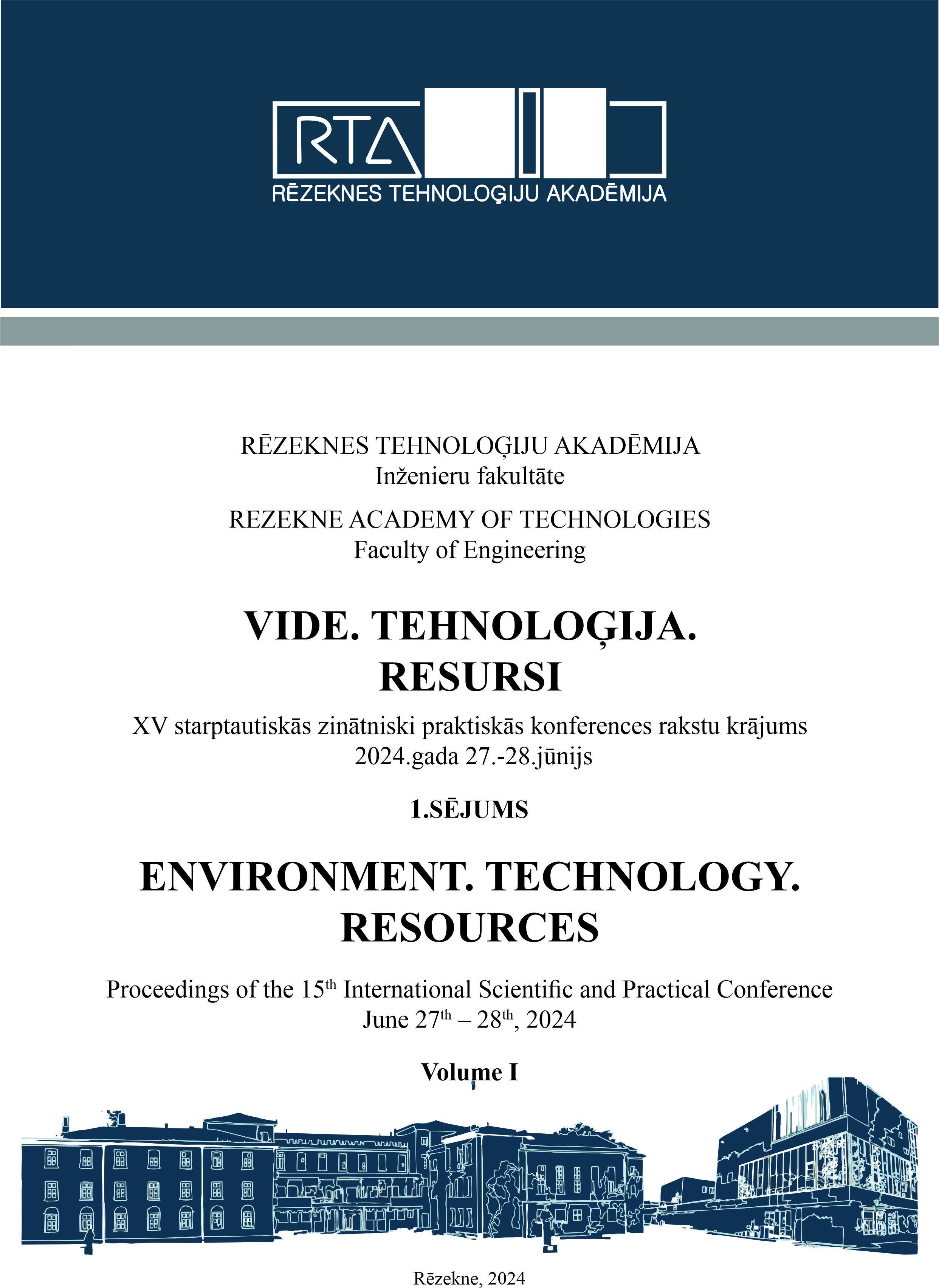THE EFFECT OF DIGESTATE AND WOOD ASH MIXTURES ON THE PRODUCTIVITY AND YIELD QUALITY OF MAIZE
DOI:
https://doi.org/10.17770/etr2024vol1.7957Keywords:
digestate, fertilizer, mixtures maize, wood ashAbstract
Maize (Zea mays L.) is one of the world's most productive and prevailing crops. It is widely grown as human food and animal feed, as biofuel, and as a raw material for industry. Digestate and wood ash are the byproducts of cogeneration plants. Digestate is rich in nutrients, can provide plants with many nutrients required by the plant during its growing season, as well as improves the soil structure. The aim of the study was to determine the effect of the rates of digestate and wood ash mixture fertilizer on maize productivity and crop quality. In 2020, 2021 and 2022, in field trials with maize, the variety 'Hulk', FAO250, was used; the soil – sod-calcareous, medium-heavy sandy loam. Different variants of the mixture of cattle manure digestate and wood ash were used as a fertilizer on corn plantations. The ratios of digestate and wood ash was 1:0, 1:1, 2:1, and 3:1; fertilizer rates were 15 and 30 t ha-1. In the trial, different types of fertilizers demonstrated different effects on the yield and quality of maize. The use of the new fertilizers produced on average 36.93–38.33 t ha-1 of high-quality maize green mass in three years without using mineral fertilizers.
References
C. Corden, K. Bougas, E. Cunningham, D. Tyrer, J. Kreißig and M. Crookes, “Digestate and Compost as Fertilisers: Risk Assessment and Risk Management Options”. Wood Environment & Infrastructure Solutions UK Limited; Aberdeen, UK, 2019. [Online]. Available: https://ec.europa.eu/environment/chemicals/reach/pdf/40039 Digestate and Compost RMOA—Final report i2_20190208.pdf. [Accessed: Feb. 20, 2024].
A. H. Bhatt and L. Tao, “Economic perspectives of biogas production via anaerobic digestion”. Bioengineerin, 7(3), 2020. [Online]. Available: https://www.mdpi.com/2306-5354/7/3/74 [Accessed: Oct. 8,2021].
A. Comparetti, P. Febo, C. Greco and S. Orlando, “Current state and future of biogas and digestate production”. Bulgarian Journal of Agricultural Science, 19, 2013, pp. 1–14.
K. Przygocka-Cyna and W. Grzebisz, “Biogas digestate – benefits and risks for soil fertility and crop quality – an evaluation of grain maize response”. Open Chemistry, 16 (1), 2018, pp. 258-271. https://doi.org/10.1515/chem-2018-002
J. Abubaker, K. Risberg, E. Jönsson, A.S. Dahlin, H. Cederlund and M. Pell, “Short-term effects of biogas digestates and pig slurry application on soil microbial activity”. Applied and Environmental Soil Science, Vol.1, 2015. [Online]. Available:https://www.hindawi.com/journals/aess/2015/658542/ [Accessed: Febr.18, 2024].
M. Hjorth, K. V. Christensen, M. L. Christensen and S. G. Sommer, “Solid-liquid separation of animal slurry in theory and practice”. Agronomy for Sustainable Development, 30, 2010, pp.153–180.
A. Herrmann, “Biogas production from maize: current state, challenges and prospects. 2. agronomic and environmental aspects”. BioEnergy Research, 6, 2013, pp. 372–387.
N. Svoboda, F. Taube, C. Kluß, B. Wienforth, H. Kage, S. Ohl, “Crop production for biogas and water protection—A trade-off”. Agriculture, Ecosystems & Environment, 177, 2013, pp. 36–47.
A. Ehmann, U. Thumm and I. Lewandowski, “Fertilizing Potential of Separated Biogas Digestates in Annual and Perennial Biomass Production Systems”. Frontiers in Sustainable Food Systems, 2018, 2:12. doi: 10.3389/fsufs.2018.00012. [Online]. Available: https://www.frontiersin.org/articles/10.3389/fsufs.2018.00012/full [Accessed: Febr.12, 2024].
A. Herrmann, K. Sieling, B. Wienforth, F. Taube and H. Kage, “ Short-term effects of biogas residue application on yield performance and N balance parameters of maize in different cropping systems”. Journal of Agricultural Science, 151, 2013, pp. 449–462.
R. M. Gatenby, Sheep. The Tropical Agricultural Series. McMillan Publishers, 2002, pp. 408–515.
E. R. Orskov, Optimizing rumen environment for cellulose digestion. In: Rumen Ecology Research Planning (Eds R. J. Wallace and A. Lahlou‑Kassi). Proceedings of a Workshop held at ILRI, Addis Ababa, Ethiopia, 13–18 March, 1995. pp. 177–182.
P. J. van Soest, Nutritional Ecology of the Ruminant. 2nd edition, Ithaca, NY, USA: Comstock Publishing Associates/ Comell University Press. 1994, 47 p.
P. C. Hoffman and D. Taysom, “How much ash are you feeding your cows”. Hoards Dairyman, 149(20), 2005, 659 p.
A. Albu, I. M. Pop and C. Radu-Rusu, “Calcium (Ca) and phosphorus (P) concentration in dairy cow feeds”. Lucrări Stiintifice – Seria Zootehnie, 57, 2012, pp. 70-74.
D. A. Miller and H. F. Reetz-Ja, Forage fertilization. In: Forages, Vol. I. An introduction to grassland agriculture. Eds. R. F. Barnes, D. A. Miller and C. J. Nelson. Iowa State University Press, Ames, Iowa, 1995, pp. 79-91.
C. Traba and P. Wolanski, Some aspects of fodder value of papilionaceous plants occurring in sward of seminatural meadows and pastures. Biul. Inst. Hod. Aklim. Rosl.,225, 2003, pp. 73-79.
K. Kumar and A. Soni, “Elemental ratio and their importance in feed and fodder”. International Journal of pure application in bioscience, 2 (3), 2014, pp.154-160.
I. Ayan, H. Mut, O. Onal-Asci, U.Basaban and Z. Acar, “Effects of manure application on the chemical composition of rangeland hay”. Journal of animal veterinary advances, 9 (13), 2010, pp. 1852-1857.
S. Grzegorczyk, J. Alberski, M. Olszewska, K. Grabowski and A. Baluch-Malecka, “Content of calcium and phosphorus and the Ca:P ratio in selected species of leguminous and herbaceous plants”. Journal of elementology, 22 (2), 2017, pp. 663-669.
Downloads
Published
Issue
Section
License
Copyright (c) 2024 Aleksandrs Adamovics, Liena Poiša

This work is licensed under a Creative Commons Attribution 4.0 International License.



